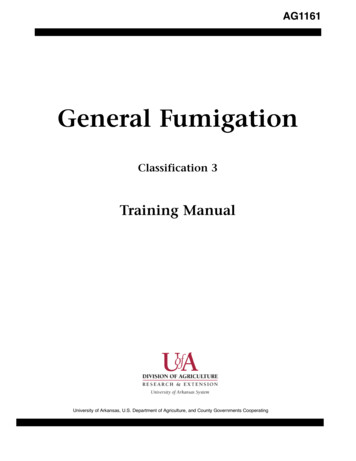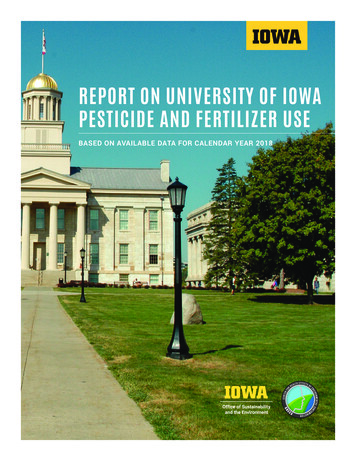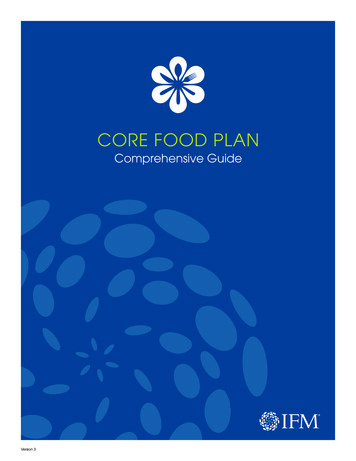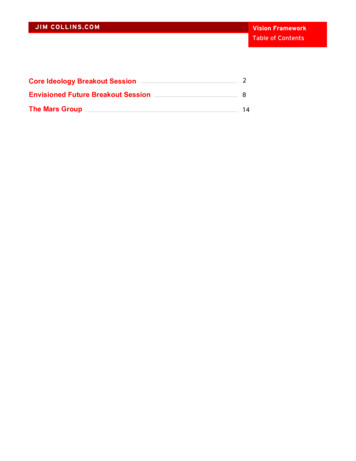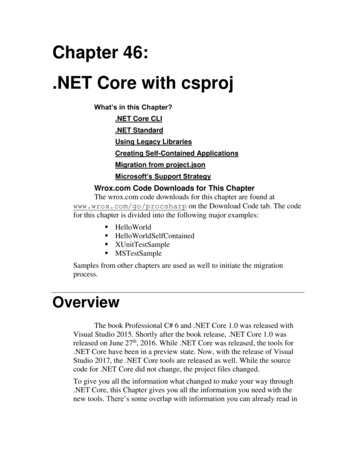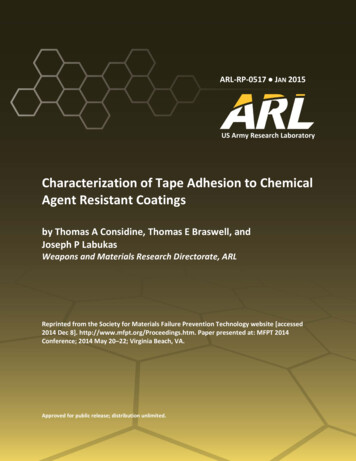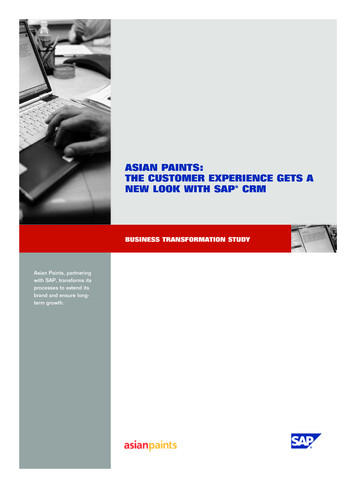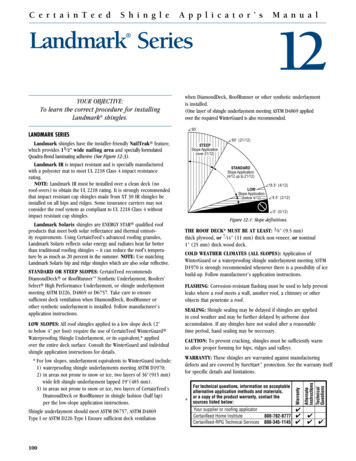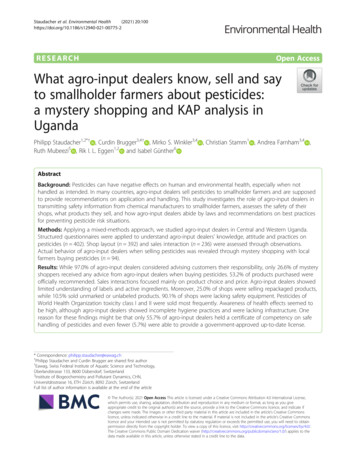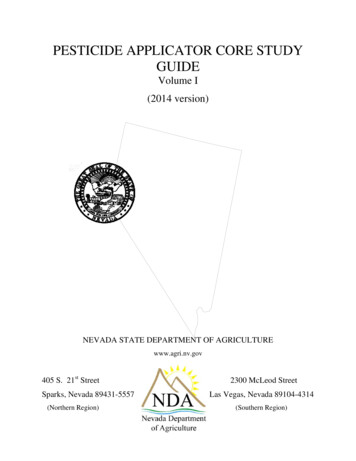
Transcription
PESTICIDE APPLICATOR CORE STUDYGUIDEVolume I(2014 version)NEVADA STATE DEPARTMENT OF AGRICULTUREwww.agri.nv.gov405 S. 21st StreetSparks, Nevada 89431-5557(Northern Region)2300 McLeod StreetLas Vegas, Nevada 89104-4314(Southern Region)
PESTICIDE APPLICATOR CORE STUDY GUIDEVolume IPreface and AcknowledgmentsThis manual was prepared as a Core study guide for pest control technicians.The enclosed sections deal with federal and state pesticide laws and regulations,pesticides, pesticides and human health, Personal Protective Equipment (PPE),calculations, safety, formulations, pesticide labels, pesticides and the environment,application equipment, and basic insect identification.Information contained herein is not intended to substitute for any pesticide labelinformation, direction or requirement. In addition, information contained herein isfurnished with the understanding that no discrimination is intended, and any referenceto a commercially known product does NOT imply an endorsement by the NevadaDepartment of Agriculture. No endorsement, guarantee, warrantee or assumed liabilityof any kind, expressed or implied, is made with respect to the information containedherein. It is the pest control licensee’s responsibility to follow all pesticide labeldirections and regulations pertaining to the control of pests.Sample labels are used in this manual only as an instructional tool. The use ofthese labels implies no endorsement by the State of Nevada or the Nevada Departmentof Agriculture.Due to on going pesticide and regulation changes, The Nevada Department ofAgriculture assumes no liability for suggested pesticide use, control techniques, orregulation changes.For Nevada’s most current pest control NAC regulations go to:http://www.leg.state.nv.us/NAC/NAC-555.htmlFor the most current NRS regulations go ributing authors to this study guide are Scott D. Cichowlaz - Pest ControlLicensing & Continuing Education, Nevada Department of Agriculture; Lee Lawrence Pest Control Licensing & Enforcement, Nevada Department of Agriculture; CharlesMoses – Environmental Scientist, Nevada Department of Agriculture; and WayneJohnson Ph.D., University of Nevada Cooperative Extension. Special recognition goesto the Nevada Pest Control Advisory Workgroup for their review of previous draftmaterials.For a more in-depth understanding of the pest control industry the Departmentwould urge an operator to read pertinent sections of the Handbook of Pest Control, A.Mallis, Editorial Director S. Hedges, 2011 (10th edition), and Truman's Scientific GuideTo Pest Management Operations, G. Bennett, J. Owens, R. Corrigan, editors, 2012 (7thedition). Pest Control Technology (PCT) also publishes several soft cover field guideswhich can prove invaluable to an applicator in the day to day operations of the business.Several of these PCT field guides are: Field Guide For The Management Of StructureInfesting Ants, Field Guide For The Management Of Urban Spiders, a two volumeedition of PCT Field Guide For The Management Of Structure Infesting Beetles andPCT Field Guide For The Management Of Structure-Infesting Flies.Revised 8/2014
POISON CONTROL CENTERThe American Association of Poison Control Centers (AAPCC) supports our nation’s 57Poison Control Call Centers through a single toll-free phone number. All local poisoncontrol centers in the United States use this national number although calls are routedthrough different centers depending on geographic location. Nevada calls are routedthrough the Rocky Mountain Poison Control Center which also services calls fromHawaii and Montana. This national hotline number will let you talk to expertsin poisoning.National Poison Control1-800-222-1222
IMPORTANT!PRIMARY PRINCIPAL APPLICANTSREAD BEFORE PROCEEDINGINFORMATION ON FINGERPRINT CARDS ANDFINGERPRINTING SERVICES FOR PRIMARY PRINCIPALLICENSE APPLICANTS ONLY.Nevada Revised Statute § NRS 555.345 - AfterJanuary 1, 2008, each applicant for a PrimaryPrincipal license will be required to, “.submit withhis application a complete set of his rtment to forward the fingerprints to theCentral Repository for Nevada Records ofCriminal History for submission to the FederalBureau of Investigation for its report.”IF YOU ARE APPLYING FOR A PRIMARYPRINCIPAL TEST OR LICENSE, YOU MUSTCONTACT THE NEVADA DEPARTMENT OFAGRICULTURE’SSPARKSOFFICEIMMEDIATELY TO RECEIVE INFORMATIONABOUT FINGERPRINT PROCEDURES ANDNECESSARY DOCUMENTS. CONTACT MARYHOSSAY AT 775-353-3712.
IMPORTANT!THIS PAGE IS INTENDED FOR NEW PRIMARY PRINCIPALAPPLICANTS ONLY.NEW PRIMARY PRINCIPAL CRIMINAL HISTORY CHECKPlease note, all NEW Primary Principal applicants are subject to FBI and Statecriminal history checks. NEW Primary Principal applicants are required to submittwo sets of fingerprints on a fingerprint card SUPPLIED BY THE NEVADADEPARTMENT OF AGRICULTURE.Primary Principal applicants who have been convicted of a felony, or havecommitted a crime of moral turpitude (molestation, rape, drug trafficking, etc.) arerequired to provide information about their conviction on a Criminal ConvictionDisclosure form supplied by the Nevada Department of Agriculture. Informationpresented on the form will be subject to review by the Nevada Department ofAgriculture. Applicants with prior convictions MAY be subject to license denial.DUE TO THE TIME IT TAKES TO COMPLETE THE FINGERPRINTINGPROCESS AND NECESSARY PAPERWORK, EACH NEW PRIMARYPRINCIPAL APPLICANT IS ADVISED TO CONTACT THE NEVADADEPARTMENT OF AGRICULTURE OFFICE IN SPARKS, NEVADA, ASSOON AS POSSIBLE TO RECEIVE A FINGERPRINT CARD AND THEREQUIRED FORMS AND OTHER INFORMATION. IN ADDITION, ALLQUESTIONS RELATING TO CRIMINAL HISTORY CHECKS, COMPLETIONOF THE FORMS, ETC., ARE TO BE DIRECTED TO THE NEVADADEPARTMENT OF AGRICULTURE’S HEADQUARTERS OFFICE INSPARKS, NEVADA.In addition to submitting fingerprints and a Criminal Conviction Disclosure form,new Primary Principal applicants will also be required to provide informationabout their pest control license history. Primary Principal applicants who have helda pest control license in another state must state whether they have ever had theirpest control license, or permit to conduct pest control, denied, revoked, orsuspended, and if so, the reason(s) for the denial, revocation or suspension.FOR ALL REQUESTS ABOUT THE FINGERPRINT CARDS, FORMS,CRIMINAL HISTORY CHECKS, ETC., CONTACT MARY HOSSAY, AT (775)353-3712.
NEVADA DEPARTMENT OF AGRICULTUREEXAMINATIONS1)All Pest Control Examinations are monitored and/or video and audiotaped.2)Anyone who cheats on an examination will be excluded from takingany pest control examination for a minimum of 6 months (NAC555.340.7).3)No cell phones, pagers or other electronic device may be taken intothe examination area or used at any time during an examination.4)No unapproved study materials, notes or other aids may be taken intothe examination area or used during an examination.5)Tests must be paid for prior to examination.6)Examinees should bring a sharp pencil, eraser, and simple nonprogrammable calculator.7)Any examinee who writes, marks on or otherwise damages an exambooklet, will be charged a 5.00 replacement fee. The exam will notbe graded until the fee is paid.
NEVADA DEPARTMENT OF AGRICULTUREEXAMINATION FEES AND SCHEDULINGAll Operator examinations must be scheduled and paid for inadvance. All fees are NON-REFUNDABLE regardless of whether theexam is taken, cancelled, or failed. Exams may be re-scheduled with aminimum of 48 hours notice.Individuals who “no show” for a Principal exam or do not cancel ascheduled Principal exam with 48 hours notice, must pre-pay for all futureexams.
Table of ContentsI.II.III.IV.V.VIVII.About Pesticides .1a.State and Federal Law .1b.Types of Pesticides .6c.How Pesticides Work.7d.The Pesticide Label.7e.Pesticide Formulations and Packaging .15f.Understanding Pesticide Labels .21g.Sample Questions .26Pesticides and Human Health .31a.How Pesticides Enter the Body .31b.Symptoms of Pesticide Poisoning .38c.First Aid Procedures .41Protective Clothing and Personal Protective Equipment .43a.Personal Protective Equipment (PPE).43b.Avoiding Heat Stress .48c.Multiple Chemical Sensitivity (MCS).51d.Indoor Air Quality.52e.Laundering Pesticide Contaminated Clothing.53Mixing, Handling and Disposing of Pesticides.55a.Transporting Pesticides Safely.55b.Mixing Pesticides Safely.56c.Applying Pesticides Safely .57d.Pesticide Spills .59e.Storing Pesticides Safely.62f.Disposing of Pesticides Safely .64Pesticide Use and the Environment .69a.Pesticide Properties.69b.Pesticide Breakdown .70c.Pesticide Effects on Wildlife .74d.Protecting Groundwater.79Integrated Pest Management .87a.Understanding IPM.87b.The “Pest Triangle”.87c.Identify the Pest.88d.Control Options .88e.What is “Control”.91f.Control Versus Eradication.91g.Setting up an IPM Program .92Calculations, Equipment, and Calibration.93a.Calculations.93b.Application Equipment.107c.Calibration .119
VIIIAerial Application .125a.Navigation Methods.125b.Computers, Spray Output Controllers, and Sensors.127c.Calibrating Equipment .128Appendix A. Insect Identification and BiologyAppendix B. Nevada Cooperative Extension – Water pH and its Effects onPesticide Stability (FS-02-36)Appendix C. Hantavirus – An UpdateAppendix D. Nevada Laws and Regulations
About PesticidesState and Federal LawsThe State of Nevada defines a “pesticide” (NRS 555.267) as:1. “any substance or mixture of substances, including any living organisms or anyproduct derived therefrom, or any fungicide, herbicide, insecticide, nematicide orrodenticide, intended to prevent, destroy, control, repel, attract or mitigate any insect,rodent, nematode, snail, slug, fungus and weed and any other form of plant or animal life orvirus, except virus on or in living man or other animals, which is normally considered to be apest or which the Director declares to be a pest.”2. “any substance or mixture of substances intended to be used as a plantregulator, defoliant, or desiccant, and any other substances intended for that use as arenamed by the Director by regulation.”Each pesticide is different and must be judged on the basis of its chemicalcomposition and its label content and do not include any “new animal drugs.”The Federal Insecticide, Fungicide, and Rodenticide Act (FIFRA) was passed in1972, and amended in 1974, 1978, and in 1988. In 1996, the Food Quality Protection Actwas signed into law. FIFRA regulates the registration, manufacturing, transportation,distribution and use of pesticides. The United States Environmental Protection Agency(EPA) administers FIFRA.Definitions:1) Certified Applicator: any individual who is authorized (trained and/or tested forcompetency in the safe and effective handling and use of pesticides) to use or supervisethe use of any pesticide that is classified as restricted use.2) “Under the Direct Supervision of a Certified Applicator”: unless otherwise prescribed byits labeling, a restricted use pesticide may be applied by a competent person acting underthe instructions and control of a certified applicator who is available if and when needed,even though such certified applicator may not be physically present at the time and placethe pesticide is applied.3) “Immediate supervision” supervision by a licensed applicator who is present andresponsible for a person applying a pesticide for pest control.4) Label: the written, printed, or graphic matter on, or attached to, the pesticide, container,device or wrapper.-1-
5) “To Use Any Registered Pesticide in a Manner Inconsistent with its Labeling”: to use anypesticide in a manner not permitted by the labeling, provided that the term shall not include:a) Applying a pesticide at any dosage, concentration or frequency less than thatlisted on the labeling.b) Applying a pesticide against any target pest not on the labeling if the applicationis to a crop, animal, or site that is listed.c) Use any equipment or method of application that is not prohibited by the labeling.d) Mix a pesticide or pesticides with a fertilizer, if the labeling does not prohibit themixture.6) General Use Pesticide: a pesticide, when applied in accordance with its directions foruse, warnings and cautions and for the uses for which it is registered, which will notgenerally cause unreasonable adverse effects on the environment.7) Restricted Use Pesticide: a pesticide, when applied in accordance with its directions foruse, warnings and cautions and for the uses for which it is registered, may generally cause,without additional regulatory restrictions, unreasonable adverse effects on the environment,including injury to the applicator. Restricted Use pesticide packaging and labels are clearlydistinguishable from general use pesticides by a text box stating “Restricted Use” displayedprominently on the front panel.8) “Pest control”: means publicly holding oneself out as being in the business of detecting,preventing, controlling or exterminating pests or otherwise engaging in, advertising orsoliciting for:a) The use for hire of pesticides or mechanical devices for the extermination, controlor prevention of infestations of pests.b) The inspection for hire of households or other structures and the submission ofreports of inspection, estimates or bids, written or oral, for the inspection,extermination, control or prevention of wood-destroying pests.9) “Primary principal”: a principal who has been designated by a pest control businessas the person responsible for the daily supervision of each category of pest control.10) “Principal”: an owner, officer, partner, member or technician of a pest controlbusiness who has qualified by examination in one or more categories of pest control.11) “Location Principal”: the primary principal at a business location of a pest controlbusiness or a principal who has been designated by a primary principal as the personresponsible for the daily supervision of the category or categories of pest control performedat a business location of the pest control business.12) “Operator”: a person who:a) Is licensed pursuant to NAC 555.360; andb) Applies a pesticide without the immediate supervision of a principal.13) “Agent”: any person who solicits business on behalf of a custom pest control licensee.-2-
The Federal Worker Protection Standard:EPA has revised its regulations governing worker protection from agriculturalpesticides. The scope of standards includes farm/ranch, forest, nursery and greenhouseworkers. This proposal expands requirements for training, warnings about applications,personal protective equipment and re-entry restrictions and adds new provisions fordecontamination, emergency medical duties, and training.The WPS reference statement will appear on agricultural pesticideproducts that require employers to provide pesticide handlers andagricultural workers with all WPS protections. These protections include: Personal Protective Equipment (PPE) (handlers only).Display and exchange of information; emergency assistance.Notification of handlers and workers about pesticide applications.Providing a decontamination site for workers and handlers.Pesticide safety training for agricultural workers and handlers.For the full text of the Code of Federal Regulations (CFR) TITLE 40 - Protection ofEnvironment; CHAPTER I – Environmental Protection Agency; SUBCHAPTER E –Pesticide Programs; PART 170 – Worker Protection Standard, go to:http://www.ecfr.gov/cgi-bin/text-idx?tpl /ecfrbrowse/Title40/40cfr170 main 02.tplAGRICULTURAL USE REQUIREMENTSUse this product only in accordance with its labeling and with the Worker ProtectionStandard, 40 CFR 170. This standard contains requirements for the protection ofagricultural workers on farms, forests, nurseries, and greenhouses, and handlers ofagricultural pesticides. It contains requirements for training, decontamination,notification, and emergency assistance. It also contains specific instructions andexceptions pertaining to the statements on this label about personal protective equipment,notification of workers, and restricted-entry intervals.Commercial Applicator Information Exchange - Pesticide application information mustbe shared between the commercial applicator and the client/grower within twenty-four (24)hours prior to the pesticide application. Information to be shared includes: date and time ofthe application, specific location, Restricted Entry Interval (REI), notification method(posting or oral warning), EPA registration number and active ingredient of pesticide(s) tobe applied.The grower, in turn, must provide the commercial applicator information regardingany REIs that are in effect within ¼ mile of the scheduled pesticide application target site,(pertains only to grower’s establishment).If it is necessary for you to meet the requirements of the WPS, you will need to obtain acopy of the WPS “How to Comply” Manual, http://www.epa.gov/agriculture/htc.html-3-
Types and Kinds of Nevada Pest Control Licenses:Fields of pest control are:(a) Aerial—The use of aircraft for the application of pesticides on standing orrunning water, agricultural crops, rangeland, forest, idle cropland and noncroplandassociated with the production of agricultural crops.(b) Agricultural ground—The use of ground equipment for the application ofpesticides on livestock, rangeland, agricultural crops, idle cropland and noncroplandassociated with the production of agricultural crops.(c) Urban structural—The use of ground equipment for the application of pesticidesin urban areas and in, on or around structures.Categories of Licenses are:(a) Aerial:(1) Insect pests—The application of insecticides, miticides andacaricides.(2) Weeds—The application of herbicides and plant regulators.(3) Desiccants and defoliants—The application of desiccants anddefoliants.(4) Fungi pests—The application of fungicides, bactericides andnematicides.(b) Agricultural ground:(1) Insect pests—The application of insecticides, miticides andacaricides.(2) Weeds—The application of herbicides and plant regulators.(3) Desiccants and defoliants—The application of desiccants anddefoliants.(4) Fungi pests—The application of fungicides, bactericides andnematicides.(5) Vertebrate pests--The application of various substances onagricultural ground for the control of vertebrate pests, including, withoutlimitation, the use of fumigants for burrowing rodents. This category doesnot include the control of vertebrate pests in, on or around industrialcomplexes, institutional complexes, dwelling units or other structuresdesigned for use by humans, or on ornamentals or turf in, on or aroundsuch structures.(c) Urban and structural:(1) Limited landscape—The control of insect pests, vertebrate pests andplant diseases and the use of plant regulators on ornamentals and turf inurban areas, including, without limitation, fruit trees in urban areas if thefruit trees are not used for commercial purposes.(2) Industrial and institutional—The control of insect pests andvertebrate pests in, on or around industrial complexes, institutionalcomplexes and dwelling units.(3) Structural—The control of wood-destroying pests, inspection forwood-destroying pests and inspection for conditions conducive toinfestations of wood-destroying pests.-4-
(4) Fumigation—The use of poisonous and lethal fumigants.(5) Aquatic—The control of insect pests, weeds and vertebrate pests inaquatic areas that are used or are intended for use in and aroundindustrial complexes, institutional complexes and dwelling units.(6) Weeds—The control of weeds in the maintenance of landscapes, turfand rights-of-way, including, without limitation, public roads, power lines,pipelines and railway rights-of-way. This category does not include thecontrol of aquatic weeds.(7) Preservation of wood—The application of pesticides directly to woodor wood products that are not a part of a habitable structure to prevent orcontrol the degradation of the wood or wood product by a wood-destroyingorganism, including, without limitation, a fungus or bacterium.Pesticide Record Keeping Requirement:Licensed Pesticide Applicators: Whereas certified applicators are only required to keeprecords of restricted use pesticides (RUP), licensed pesticide applicators are required tokeep accurate and legible written records of each pesticide application. NAC 555.410states:1. Keep accurate and legible records for 2 years of each property treated,showing:(a) If the person is licensed in the aerial or agricultural ground field:(1) The date of the treatment.(2) The full name of the person for whom and the county where thetreatment was conducted.(3) The full name of the pilot or applicator doing the treating.(4) The crop or site treated or, in the case of a spot treatment, theterm “spot treatment” must be noted, followed by a description of thetreatment area and the spot or spots treated.(5) The number of units treated, including, without limitation, thenumber of acres or miles or fraction thereof.(6) The number, name or site identification of the field.(7) The brand name or generic name of the pesticide that wasapplied, the registration number assigned to the pesticide by theEnvironmental Protection Agency and the dosage applied.(8) The purpose for which the crop, site or spot was treated.(9) The time the treatment was started and the time the treatmentwas finished.(10) The temperature at the start and finish of the treatment.(11) The wind velocity and wind direction at the start and finish ofthe treatment.(b) If the person is licensed in the urban and structural field:(1) The date of the treatment.(2) The address where the treatment was conducted.(3) The full name of the applicator.(4) The site treated, including, without limitation, the kitchen, thecrawlspace beneath the structure, and the yard or area surroundingthe structure. In the case of a spot treatment, the term “spot-5-
treatment” must be followed by a description of the treatment areaand the spot or spots treated.(5) The brand name or generic name of the pesticide that wasapplied and the registration number assigned to the pesticide bythe Environmental Protection Agency.(6) The total amount of any diluted pesticide and the concentrationof the pesticide that was applied.(7) If the treatment is conducted in the categories of limitedlandscape, weeds, aquatic or fumigation:(I) The temperature at the start and finish of the treatment.(II) The wind velocity and direction at the start and finish ofthe treatment.(III) The area of any turf or ground treated.(IV) The purpose for which the pesticidewas applied.(V) The area or volume fumigated.(VI) The times at which fumigation startedand finished.Your personal protection is not the only reason for keepingpesticide application records. Many herbicides can be used safely on certain sites or crops,but may be fatal to others. Without written records, it is difficult to know what pesticideshave been used on a site during the previous few years. More detailed information aboutrecord keeping requirements can be obtained from the Nevada Department of Agriculture.Types of PesticidesTwo common ways of grouping pesticides are according to what pests they controland how the pesticide works to control them. The following is a listing of various pesticideclasses. Insecticides are chemicals used to control insects and other related organisms,such as ticks, spiders, centipedes and mites. Often the word “insecticide” isconfused with the word “pesticide”; however, it is just one of many types ofpesticides. Herbicides are chemicals used to control unwanted plants (i.e. weeds). Fungicides are chemicals used to kill or inhibit fungi that cause rot, leaf spotting,blights, mildews and rusts on plants, or wood rot. Nematicides are chemicals used to control nematodes that cause certain plantdiseases. Bactericides are chemicals used to kill bacteria. Some bacteria cause plantdisease. Rodenticides are chemicals used to control rats, mice, and other rodents. Fumigants are gases designed to kill insects and other organisms in confinedspaces. They are hazardous and require special precautions. Those who applyfumigants must be licensed in the fumigation category (category C4).-6-
Although not usually thought of as pesticides, the following three classes ofchemicals are also regulated as pesticides under both federal and state laws. Defoliants are chemicals that cause leaves or foliage to drop from plants. Desiccants are chemicals that promote drying or loss of moisture from plant tissue. Growth regulators are substances that alter the normal or expected growth ofinsects or plants, and/or alter insect or plant reproductionHow Pesticides WorkPesticides can also be grouped according to how they control pests. Read the labelto find out what each pesticide will do. Selective pesticides are effective against a limited group of pests (for example,ants), as opposed to non-selective pesticides which control all related pests. Forexample, a non-selective insecticide will destroy all insects it contacts. Residual or persistent pesticides actively kill pests for at least a week, and in somecases several weeks or even years (usually herbicides) after application.Conversely, non-residual or non-persistent pesticides breakdown rapidly afterapplication. Contact pesticides control the pest on contact. Contact pesticides are applied tothe surface of an animal, plant, or structure. The pest is killed upon coming incontact with the pesticide. Systemic or translocated pesticides are absorbed by plants or animals, and movefrom the site of absorption to other tissues. For example, a systemic insecticide likeMerit is absorbed by the plant and moved throughout its tissues, killing insects thatfeed on it.The Pesticide LabelThe pesticide label is the information printed on the container, including anyadditional information included with the product. The label represents the best singlesource of information available to the applicator. The label is a “legal document”. Itsimportance to the buyer or user can not be overstated. It is the source of facts on how thepesticide is to be legally handled and used.Pesticide Properties:Information contained on the pesticide label is based on scientific researchconducted to register the pesticide. Information on the pesticide’s properties and its humanhealth and environmental hazards must be submitted to the Environmental ProtectionAgency (EPA) for review and approval. If the pesticide is not approved, its registrationapplication will be rejected.-7- p
PESTICIDE APPLICATOR CORE STUDY GUIDE Volume I (2014 version) NEVADA STATE DEPARTMENT OF AGRICULTURE www.agri.nv.gov 405 S. 21st Street 2300 McLeod Stre

